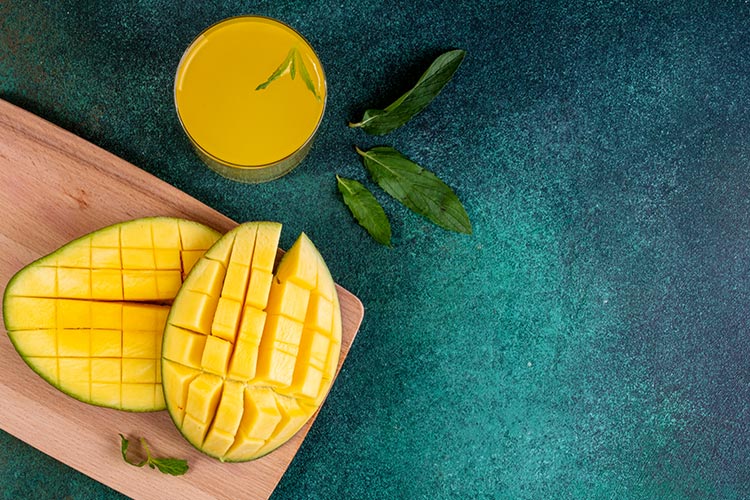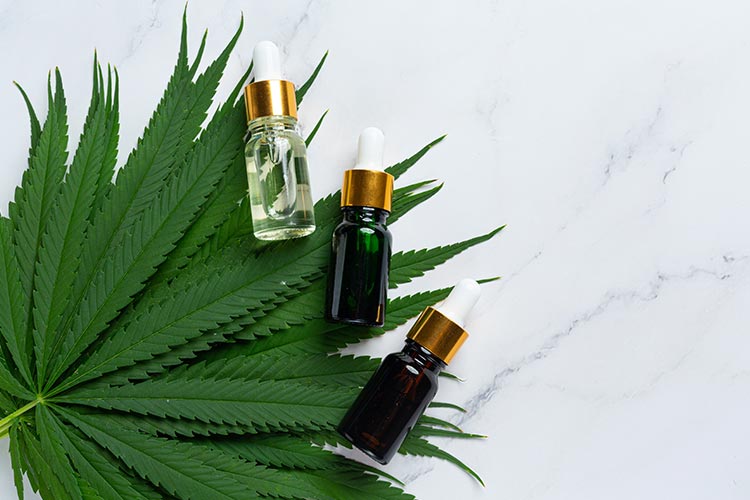Mysterious, aromatic, and beguiling, terpenes are one of the most fascinating compounds in the cannabis ecosystem. As the primary olfactory components in the marijuana plant, terpenes contribute a dizzying array of scents, flavors, and potential medical benefits to cannabis strains. And without any doubt, the most crucial of them all is the topic of today’s post: the myrcene terpene.
What is myrcene, and what makes it so special? Sometimes referred to as “The Mother of All Terpenes,” myrcene plays an outsized role in the cannabis world, imparting its own list of effects and aromas while helping synergize the actions of other molecules. In this article, we’ll help you get your head around this cannabis power player, covering such questions as:
- What is myrcene?
- What does myrcene smell and taste like?
- What are some common myrcene terpene effects?
- What are some documented myrcene benefits?
Okay, let’s get rolling….
What Is Myrcene?
We’ve written previously about terpenes, and how they play a major role in determining the aromatic profiles of specific cannabis strains. Linalool, for instance, contributes a distinctive lavender-like aroma to classic Kush strains, while limonene adds a citrusy bite to strains in the “Purple” family. But the myrcene terpene is truly in a class of its own.
It is the most abundant terpene in cannabis by weight and the primary cannabinoid in the plant. While you might not pick out myrcene’s aroma on its own—more on that in a moment—you’d definitely notice if it weren’t there. And that’s the perfect excuse to turn to a discussion of the sensory experience of the myrcene terpene.
The Myrcene Terpene: Aromatic and Flavor Profile
Even if you’re new to cannabis, you’re probably familiar with “that weed smell.” And while myrcene is only one of the literally hundreds of terpenes found in cannabis, it contributes a distinctly earthy and clove-like scent— some compare its aroma with that of ripe fruit or aged vinegar—that at higher concentrations can turn downright pungent. Elsewhere in nature, myrcene is found in thyme, mangoes, lemongrass, and the hops that flavor most beers.
 Which strains are high in myrcene? We’ll explore that in more depth in a moment, but given how prevalent myrcene is, it might be easier to find ones that aren’t! As such, myrcene makes an appearance in every strain, from the cerebrally stimulating Blue Dream to the heavy-hitting OG Kush to CBD-rich Harlequin, a favorite for inspiring creative spark.
Which strains are high in myrcene? We’ll explore that in more depth in a moment, but given how prevalent myrcene is, it might be easier to find ones that aren’t! As such, myrcene makes an appearance in every strain, from the cerebrally stimulating Blue Dream to the heavy-hitting OG Kush to CBD-rich Harlequin, a favorite for inspiring creative spark.
This brings up an important point about terpenes such as myrcene and the role they play in cannabis. While terpenes exert their own effects on our bodies and our minds, they’re completely distinct from cannabinoids such as THC and CBD. If you’re looking for specific medical effects such as treating many of the symptoms associated with anxiety and depression or insomnia, we recommend you start by focusing on cannabinoid ratios first, as they’ll ultimately have a greater impact.
Speaking of impact, let’s turn to the topic of myrcene benefits, and why this single terpene has such a major effect on the cannabis ecosystem.
What Does Myrcene Do? Effects and Benefits
As a growing body of research suggests, terpenes play an important role in terms of imparting specific medical and subjective effects. Still, most researchers agree that myrcene is the most important one of them all, synergizing the actions of other terpenes and potentially interacting with cannabinoids such as THC and CBD.
In fact, we humans have known about myrcene’s benefits for a far longer time than you might suspect. Long before anyone even knew what cannabis terpenes were, myrcene was already in use as a natural inflammation fighter. Today, clinical studies back this up, demonstrating that myrcene exhibits both anti-inflammatory and analgesic (or “pain-fighting”) qualities as well.
Myrcene is often cited as a potential sleep aid. And at least one clinical study points to the myrcene terpene’s potential in fostering deeper, more restorative rest. That may be the reason myrcene was historically implicated in the infamous “couch lock” syndrome associated with indica-leaning strains of cannabis.
That said, it appears that theories linking myrcene to indica and indica-leaning strains are but a pipe dream. As at least one study suggests, cannabis is far too complex an organism to characterize on the basis of a single terpene, even one as important as myrcene.
However, it appears that myrcene is definitively associated with one very unusual characteristic in cannabis: Playing a role in the so-called “entourage effect” (sometimes known as “ensemble effect”). In simple terms, the entourage effect is a phenomenon by which the natural compounds in cannabis interact to exert more powerful effects than they would on their own.
First proposed by Dr. Raphael Mechoulam—the Israeli researcher who did so much to unlock the secrets of cannabis, including first identifying THC as the source of the plant’s distinctive “high”—the idea behind the entourage effect suggests a vastly complex web of potential interactions between the many compounds found in cannabis.
While there’s far more to be learned, clinical research so far suggests the effect is real, even as its exact mechanisms remain unknown. For instance, one study from 2021 suggests that myrcene may work in partnership with THC and CBD to potentiate—or boost—their effects, though the evidence is somewhat cloudy. Another study shows that myrcene helps speed the transdermal absorption of cannabinoids, for instance those used in topicals.
This effect isn’t limited to myrcene. One study from 2011 suggests that the terpene alpha-pinene interacts with THC, helping to counteract the cannabinoid’s negative impact on short-term memory. Yet another study found that—while using an in vitro rodent model—several common terpenes directly activated cannabis receptor cells, suggesting that the interactions between these two major classes of cannabis compounds have been working in far closer partnership than initially suspected.
 That said, there are dissenting opinions. One study from 2020 found the exact opposite, concluding that five common terpenes—including myrcene—all failed to elicit an ensemble effect by binding to the receptors in the endocannabinoid system.
That said, there are dissenting opinions. One study from 2020 found the exact opposite, concluding that five common terpenes—including myrcene—all failed to elicit an ensemble effect by binding to the receptors in the endocannabinoid system.
Introduction to High-Myrcene Strains
As we suggested earlier, it might be easier to identify strains that lack significant quantities of myrcene than to identify all the ones that feature it. Statistically, myrcene is the most abundant terpene found in cannabis. According to one source, it accounts for roughly 20% of all terpenes found in cannabis overall. That said, let’s take a little guided tour of a few of the most notable high-myrcene strains:
- Sunflower Purple Myrcene: From local DC cultivators Molecular Farms comes a myrcene-heavy strain that offers a great way to relax. Don’t let its vibrant green bud accentuated by bright orange pistils fool you, this strain will help you unwind and kick back after a long day.
- Blue Dream or Takoma Dream. This popular and readily available strain is characterized by sweet berry aromas and gentle cerebral effects. Its high myrcene content contributes to its anti-inflammatory and analgesic qualities.
- White Runtz: A potent, crystal-dusted strain, this classic cultivar is known for imparting a strong euphoric and energizing effect. Those resinous crystals should serve as a warning: This is typically a potent strain with a high THC content.
- Diesel: This family of pungently scented strains are generally known to exhibit classic uplifting and buzzy characteristics, thanks to their generous myrcene and limonene contents.
- Northern Lights: As one of the most famous indica strains of all, Northern Lights (or simply “NL”) is known for a long-lasting euphoria that helps reduce stubborn chronic symptoms such as pain, anxiety, and stress.
- Mango: This family of mango-scented strains hearkens back to an enduring cannabis myth. Because mangoes are naturally high in myrcene, so the saying goes, consuming one about 45 minutes before enjoying cannabis boosts the intensity of the high. While we can’t vouch for the practice ourselves, there’s certainly no harm in trying…
- Kush: We’d be remiss if we left out the Kush family, without doubt one of the most renowned in the cannabis world. Originally descended from the deeply relaxing strains grown in the foothills of the Kush Mountains of Northern India, these strains tend to be potent, flavorful, and memorable.
Explore Myrcene with DC’s Best Selection of Cannabis Flower, Edibles, and More
If reading this post has gotten you fired up about myrcene, we’d love to help you sample it for yourself! While our menu changes regularly based on what’s fresh, we typically stock a wide variety of cannabis products high in myrcene, including Sunflower Purple Myrcene by Molecular Farms, a premium flower that provides a healthy dose of this medically impactful terpene.
As the District’s #1 family-run dispensary, we take pride in helping our customers get the very most from their cannabis purchases. If you have further questions about the myrcene terpene (or any other cannabis-related questions), just ask! We’re here to help.


